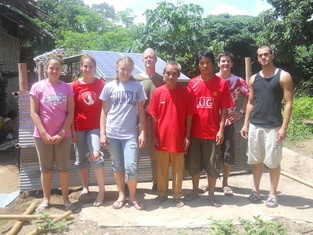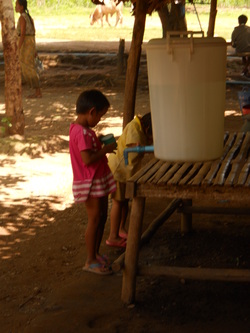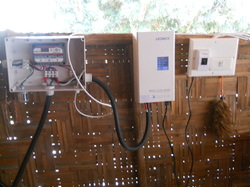Mission

The team of students who set up the solar powered systems, by Courtney Neth
In July of 2010, Courtney Neth age 17, had the opportunity to journey to Thailand with her teacher Doug Hollinger and a group of 5 young adults from Pavilion High School to build solar powered water purifiers in the schools where the refugee children are residing. Many of these children were orphans and hence cared for younger siblings, since their parents were not able to yet escape from the trepidations in Burma. In an interview with Neth, she said “One of the most moving things I saw was a little boy about five, holding his baby brother, because that was all he had.”
The team stayed in a city called Mae Sot, where they rented a house and rode their bikes to the refugee camps each day. Throughout the course of three weeks they installed three solar powered water purification systems and electricity in three school based refugee camps. With the assistance of the school electrician the team was able to install a solar array to power the schools and water purification systems. The systems consisted of a large solar panel stationed outside of the school which was wired to a charge controller. When the energy from the sun hits the solar panel, the electrons that were stable become unstable, releasing electricity that goes through the charge controller. This device controls the amount of energy and electricity that comes in and out, so the batteries do not overload and fail. Attached to this device is the water purification system which begins with a loading bucket at the top of the structure where the contaminated water is held. When the valve is opened water filters through the PVC pipe into a cylinder that is exposed to an ultra violet light which kills hazardous bacteria and other organisms. This system can clean water at a rate of four liters per minute and hence is more beneficial for the children and people to drink so there is a lower risk of contamination and sickness.
After the systems were installed the team took a day to teach the men and older boys how to use and maintain the solar panels and the electrical system. A plethora of translators were required to help teach, due to the diverse dialects. However it seemed as if the people comprehended the specific instructions for usage and maintenance, and they left the camp with success as the schools were now equipped with electricity and clean water. According to Neth, the teachers currently leave a cup by the water purification bucket and hence the children can easily acquire a sanitary drink by simply turning on the valve and filling the cup. According to Neth the best part about going to Thailand was playing with the kids and learning about the different kinds of cultures, comparing them against the United States. These systems greatly impacted the lives of the refugees economically, socially and individually.
These solar arrays and electrical systems were paid for by donations from parents and fund raising. The entire trip however was composed of funds raised in fund raising activities by the young adults. They were required to pay for the house and the flight over and back from Thailand. The people in Thailand have been supporting the Burmese refugees setting up different foundations such as the Karen foundation, which sells handmade item with proceeds to go to the Burmese children present in schools and refugee camps.
The team stayed in a city called Mae Sot, where they rented a house and rode their bikes to the refugee camps each day. Throughout the course of three weeks they installed three solar powered water purification systems and electricity in three school based refugee camps. With the assistance of the school electrician the team was able to install a solar array to power the schools and water purification systems. The systems consisted of a large solar panel stationed outside of the school which was wired to a charge controller. When the energy from the sun hits the solar panel, the electrons that were stable become unstable, releasing electricity that goes through the charge controller. This device controls the amount of energy and electricity that comes in and out, so the batteries do not overload and fail. Attached to this device is the water purification system which begins with a loading bucket at the top of the structure where the contaminated water is held. When the valve is opened water filters through the PVC pipe into a cylinder that is exposed to an ultra violet light which kills hazardous bacteria and other organisms. This system can clean water at a rate of four liters per minute and hence is more beneficial for the children and people to drink so there is a lower risk of contamination and sickness.
After the systems were installed the team took a day to teach the men and older boys how to use and maintain the solar panels and the electrical system. A plethora of translators were required to help teach, due to the diverse dialects. However it seemed as if the people comprehended the specific instructions for usage and maintenance, and they left the camp with success as the schools were now equipped with electricity and clean water. According to Neth, the teachers currently leave a cup by the water purification bucket and hence the children can easily acquire a sanitary drink by simply turning on the valve and filling the cup. According to Neth the best part about going to Thailand was playing with the kids and learning about the different kinds of cultures, comparing them against the United States. These systems greatly impacted the lives of the refugees economically, socially and individually.
These solar arrays and electrical systems were paid for by donations from parents and fund raising. The entire trip however was composed of funds raised in fund raising activities by the young adults. They were required to pay for the house and the flight over and back from Thailand. The people in Thailand have been supporting the Burmese refugees setting up different foundations such as the Karen foundation, which sells handmade item with proceeds to go to the Burmese children present in schools and refugee camps.


